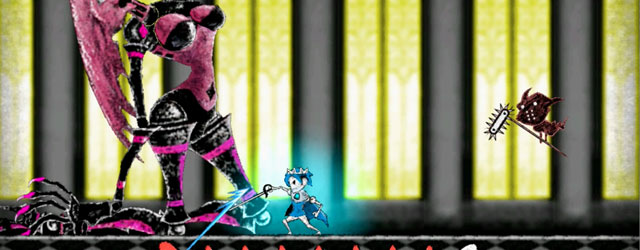[tab:Review]
Remember that girl? You know the one. The one you couldn’t stop thinking about, but that didn’t even seem to know you existed. You’d do anything to get her to notice you. You’d fantasize about swooping her up and saving her from some imaginary threat. Remember when you were a skeleton and she was a princess that had been captured by your boss, the Dark Lord, who planned to force her to marry him? No? OK, so maybe your story and Dokuro’s aren’t exactly the same, but this typical story wrapped in an atypical setting will still probably tug at some strings. Dokuro spins its tale of unrequited love and rescue against a unique chalk drawing backdrop and serves up puzzles equal parts captivating and exasperating.
Dokuro’s charming gameplay revolves around leading the aforementioned princess out of the Dark Lord’s castle. The princess must have spent a great deal of her childhood playing “Lemmings” because she has the nasty habit of walking until she hits something she can’t get past. Dokuro will have to guide her around traps, over pits, and past enemies to reach the flower that signifies the end of an area. Each zone contains a new tricky puzzle that will require both brains and dexterity to get past. Luckily, Dokuro has plenty of tricks up his sleeve to make this happen.
As mentioned, the princess doesn’t notice our tiny skeleton hero. Thankfully, Dokuro runs across a potion that can turn him temporarily into a dashing hero (complete with sword). While in this heroic form, the princess not only notices him but can also be scooped up and carried across treacherous territory. The potion slowly depletes as Dokuro stays in the form and then replenishes itself after he returns to his normal (unnoticed) self. While in the hero form, Dokuro loses his ability to jump (mostly) but his sword allows him to destroy any enemies in his path. If I can give you one tip though, it’s probably a good idea to switch this power to the R button rather than double tapping the screen. I found the touch screen method somewhat unreliable at consistently switching between the two forms.
Pulling from its chalk drawing setting, Dokuro also has the power to use chalk to his advantage. Different colors cause different effects, which I won’t spoil here. This ability does a good job at both providing multiple options for great puzzles but also connecting them to the unique backdrop. I did find that the touch controls related to this functionality were hit and miss however, and the detection issues (while somewhat rare) did add to the frustration in several areas.
Each level is a part of a larger stage, which may feature a boss character at the end. Dokuro is relatively fragile and is only able to take two hits before dying. Because of this, the boss battles shape up as puzzles of their own as you scramble to find a way to deplete the boss’ health while conserving your own limited supply. I found these exchanges to be welcome changes of pace as it relates to the rest of the gameplay.
The visual aspect of Dokuro is easily the game’s greatest strength. The atmosphere built by both the art style and characters is fantastic and quite impressive for a game with no voice acting to speak of. Everything from the enemies to the design of the castle and the puzzles you’ll eke your way through oozes with charm. Perhaps my favorite effect is how the background colors change in certain areas when Dokuro changes between his normal visage and his hero form. Ultimately, this is the type of game where the visual design elevates everything else.
A puzzle game is only as strong as its mind teasers and Dokuro walks the line between clever and contentious. What might be the most unfortunate negative in the game is the fact that there is no smooth, predictable difficulty curve. While this may be ideal for huge fans of the genre that occasionally want a large spike in difficulty, for the more moderate puzzle fan, some areas will quickly become frustrating. Seemingly in complete self awareness of this the developers have added a nice feature that allows you to skip troublesome areas. You can skip up to 10 areas before the game makes you go back and earn your skips back by completing them. This helps allow players who may be frustrated by the uneven difficulty to reassess levels later with a cooler head.
For gamers anxious for a great puzzler that they can hit the road with, Dokuro is a great choice. Fans of the genre will love the art style, characters, and cleverly designed traps. Casual fans of this particular style of game though may find themselves boxed in by some random spikes in difficulty and some occasional glitches in the touch controls. In the end, those of you looking for a fun and unique experience will certainly be satisfied here.
Review copy of game provided by publisher.
[tab:Screenshots]
[tab:END]

